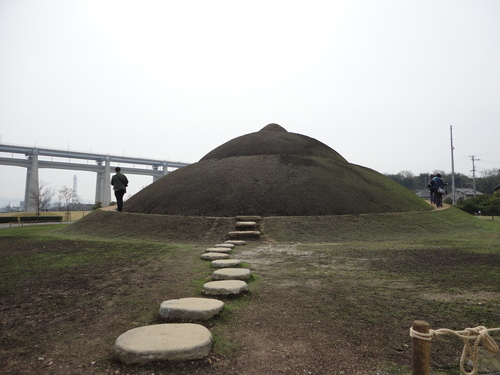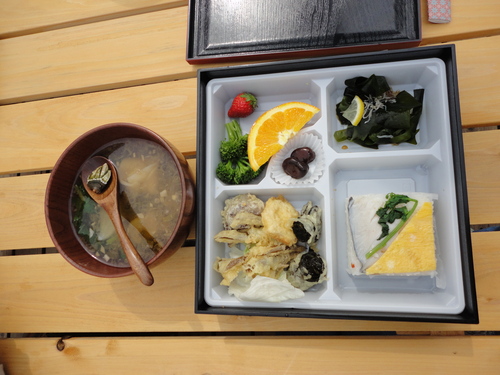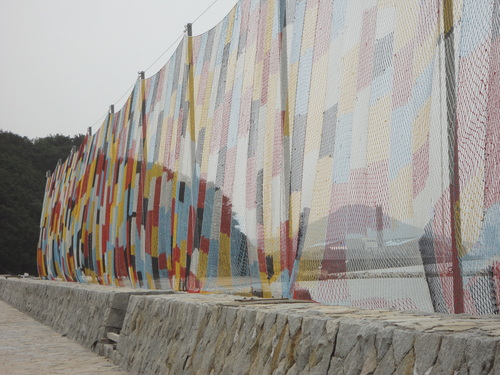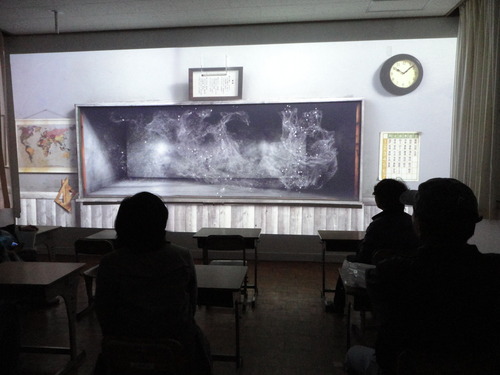2013年03月29日
The Setouchi Triennale 2013 - Shamijima
For those who haven’t been following, the Triennale is a contemporary art festival in the beautiful setting of the Seto Inland Sea (see http://setouchi-artfest.jp/en/ ). Today, let me share just a few glimpses of one of the new additions, Shamijima. A tiny little island, it is one of the few that has a stable rather than a declining population. This is thanks to the fact that it is no longer an island but rather connected to the mainland, which makes it easy to commute. This also makes it easy to visit by car or by train and bus. (Take the JR line to Sakaide and catch an hourly bus.)

The first art site that greets the visitor is Tanya Preminger’s “100 Stratums”. When I went in early March, it was still in process with Tanya fearlessly directing a great big digger to create a hill, and digging away with her shovel to shape the earth as she wished.

And here’s the finished product. The work uses no contemporary materials, only earth and grass, yet these primitive materials spark the imagination, generating “stratums” of thoughts. At least that’s the idea, and I would have to say that Tanya succeeded! A very interactive work that is great fun to climb.



Our next stop was Eat & Art Taro. It was only 10:30, not time for lunch, but Triennale staff warned us that the Island Soup sells out early.
As we lined up for soup, the artist himself was there to describe the project. He spent many weeks combing the area to find indigenous ingredients that have been used for a 1000 years.

The soup (JPY500) is made only from these and flavored with salt and sesame oil. It’s a very light soup with 2 chewy chicken dumplings and what I would swear is a barnacle! But it was very tasty and quite an experience.

The box lunch (JPY600), made by the island women, was really good and the outdoor dining along the beach was a treat. I’m not sure what the plan is for rainy days but they don't have to worry about summer heat as the site is only open in the Spring Season (until April 21). In other words, go now!


Stroll past the restaurant and you’ll come to Igarashi’s work, “Knitting the Sky”.

Local fishermen from all 5 islands in the Shamijima group taught local residents and volunteers how to knit fishing nets. They produce patches in 5 colors, representing the 5 islands as well as 5 elements in nature, which Yasuaki Igarashi stitched together to create this truly collaborative work.

It is meant not just to be seen, but also to seen through. It produces a really lovely and illusory effect.
We next took a stroll over the hill to the former elementary school which features installations by various artists affiliated with Kobe Design University. I must admit I was very pleasantly surprised by the caliber of the works here. The overall theme is “the three whites” which refers to 3 regional products known as Sanuki sanpaku (salt, sugar, and cotton), and each work deals with something white. Visitors entering the corridor are greeted by the sight of white Styrofoam collected from the sea floating ethereally in the air.

In a darkened room, a net of crystallized salt by Hana Sakuma sparkles like diamonds.

This is followed by a work painted with shells collected from the beach and painstakingly crushed by hammer (“Kaisou-shamijima” by Yukie Ohata). The textures were quite striking but much better seen in person so instead here is photo of the artist's message to visitors showing how the work was made. It's also painted not with chalk but with crushed shell paint.

The final work, “Shiro” by Kentaro Hayashi, is a totally white classroom complete with a white “blackboard” on which is projected the passage of time.

What I didn’t realize until we were on our way out is that the café at the entrance is also an installation. The table is shaped like Shamijima and the wall mural is a collaborative effort of the artist with local children. Lots of fun to look at, and you can enjoy sweets and coffee while you’re there.
And Shamijima is not just art. If you go, take a walk past this bench (another artwork) and around the shore.

“Love Nine-legged race, LOVE” by Syuzo Fujimoto
You’ll find a lovely little hiking trail through the woods that offers great views of the sea and islands.


Sakaide is just a 15-min. train ride from JR Takamatsu station and the buses to Shamijima run at least every hour during the Triennale. For more about the Triennale, see http://setouchi-artfest.jp/en/ .
Takamatsu Access:
Takamatsu can be reached by direct flights from Tokyo’s Haneda Airport (about 1 hour), by limousine bus from Kansai International Airport (about 3 hours), and by direct flights from China, Korea and Taiwan. It can also be reached by taking the bullet train to Okayama (4 hours from Tokyo) and changing to the Marine Liner bound for Takamatsu (runs every 1/2 hour; takes 1 hour).
Hotels: http://www.japanican.com/index.aspx (when selecting the area of stay, scroll down to “Other Popular Options” and select “Takamatsu/Tokushima/Awashima”.)
Also check: http://www.kagawa-yadonet.or.jp/en/

The first art site that greets the visitor is Tanya Preminger’s “100 Stratums”. When I went in early March, it was still in process with Tanya fearlessly directing a great big digger to create a hill, and digging away with her shovel to shape the earth as she wished.

And here’s the finished product. The work uses no contemporary materials, only earth and grass, yet these primitive materials spark the imagination, generating “stratums” of thoughts. At least that’s the idea, and I would have to say that Tanya succeeded! A very interactive work that is great fun to climb.



Our next stop was Eat & Art Taro. It was only 10:30, not time for lunch, but Triennale staff warned us that the Island Soup sells out early.
As we lined up for soup, the artist himself was there to describe the project. He spent many weeks combing the area to find indigenous ingredients that have been used for a 1000 years.

The soup (JPY500) is made only from these and flavored with salt and sesame oil. It’s a very light soup with 2 chewy chicken dumplings and what I would swear is a barnacle! But it was very tasty and quite an experience.

The box lunch (JPY600), made by the island women, was really good and the outdoor dining along the beach was a treat. I’m not sure what the plan is for rainy days but they don't have to worry about summer heat as the site is only open in the Spring Season (until April 21). In other words, go now!


Stroll past the restaurant and you’ll come to Igarashi’s work, “Knitting the Sky”.

Local fishermen from all 5 islands in the Shamijima group taught local residents and volunteers how to knit fishing nets. They produce patches in 5 colors, representing the 5 islands as well as 5 elements in nature, which Yasuaki Igarashi stitched together to create this truly collaborative work.

It is meant not just to be seen, but also to seen through. It produces a really lovely and illusory effect.
We next took a stroll over the hill to the former elementary school which features installations by various artists affiliated with Kobe Design University. I must admit I was very pleasantly surprised by the caliber of the works here. The overall theme is “the three whites” which refers to 3 regional products known as Sanuki sanpaku (salt, sugar, and cotton), and each work deals with something white. Visitors entering the corridor are greeted by the sight of white Styrofoam collected from the sea floating ethereally in the air.

In a darkened room, a net of crystallized salt by Hana Sakuma sparkles like diamonds.
This is followed by a work painted with shells collected from the beach and painstakingly crushed by hammer (“Kaisou-shamijima” by Yukie Ohata). The textures were quite striking but much better seen in person so instead here is photo of the artist's message to visitors showing how the work was made. It's also painted not with chalk but with crushed shell paint.

The final work, “Shiro” by Kentaro Hayashi, is a totally white classroom complete with a white “blackboard” on which is projected the passage of time.

What I didn’t realize until we were on our way out is that the café at the entrance is also an installation. The table is shaped like Shamijima and the wall mural is a collaborative effort of the artist with local children. Lots of fun to look at, and you can enjoy sweets and coffee while you’re there.
And Shamijima is not just art. If you go, take a walk past this bench (another artwork) and around the shore.

“Love Nine-legged race, LOVE” by Syuzo Fujimoto
You’ll find a lovely little hiking trail through the woods that offers great views of the sea and islands.


Sakaide is just a 15-min. train ride from JR Takamatsu station and the buses to Shamijima run at least every hour during the Triennale. For more about the Triennale, see http://setouchi-artfest.jp/en/ .
Takamatsu Access:
Takamatsu can be reached by direct flights from Tokyo’s Haneda Airport (about 1 hour), by limousine bus from Kansai International Airport (about 3 hours), and by direct flights from China, Korea and Taiwan. It can also be reached by taking the bullet train to Okayama (4 hours from Tokyo) and changing to the Marine Liner bound for Takamatsu (runs every 1/2 hour; takes 1 hour).
Hotels: http://www.japanican.com/index.aspx (when selecting the area of stay, scroll down to “Other Popular Options” and select “Takamatsu/Tokushima/Awashima”.)
Also check: http://www.kagawa-yadonet.or.jp/en/
My Profile
Cathy Hirano キャシー ヒラノ
I've lived in Japan since 1978. After graduating from a Japanese university with a BA in cultural anthropology in 1983, I worked as a translator in a Japanese consulting engineering firm in Tokyo for several years. My Japanese husband and I moved to Takamatsu in 1987 to raise our two children in a slower-paced environment away from the big city pressures. We've never regretted it. I work as a freelance translator and interpreter and am involved in a lot of community work, including volunteering for Second Hand, a local NGO that supports educational and vocational training initiatives in Cambodia, and for the Takamatsu International Association. I love living in Takamatsu.
Cathy Hirano キャシー ヒラノ
I've lived in Japan since 1978. After graduating from a Japanese university with a BA in cultural anthropology in 1983, I worked as a translator in a Japanese consulting engineering firm in Tokyo for several years. My Japanese husband and I moved to Takamatsu in 1987 to raise our two children in a slower-paced environment away from the big city pressures. We've never regretted it. I work as a freelance translator and interpreter and am involved in a lot of community work, including volunteering for Second Hand, a local NGO that supports educational and vocational training initiatives in Cambodia, and for the Takamatsu International Association. I love living in Takamatsu.
Posted by cathy at 20:41│Comments(1)
この記事へのコメント
Interresting blog and wonderfull fotos, congratulations;best regard from Belgium.
http://retriever-louisettesblogs.blogspot.com
http://retriever-louisettesblogs.blogspot.com
Posted by Louisette at 2013年05月18日 08:55
※会員のみコメントを受け付けております、ログインが必要です。





